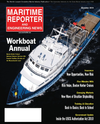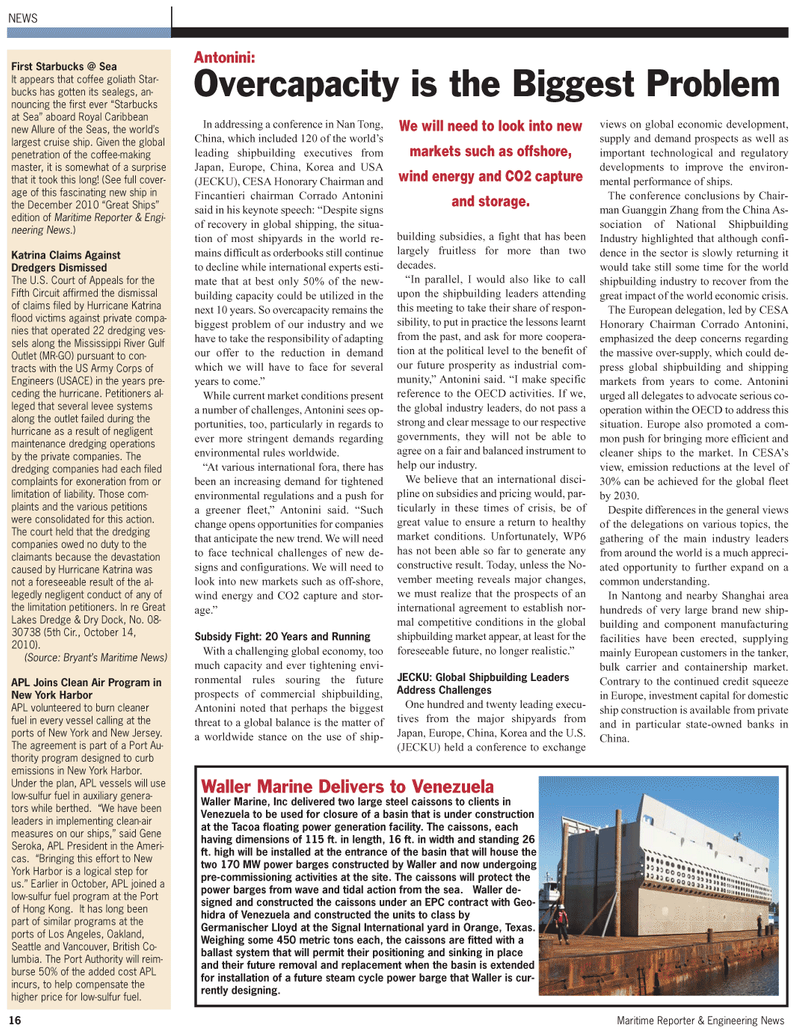
Page 16: of Maritime Reporter Magazine (November 2010)
Workboat Annual
Read this page in Pdf, Flash or Html5 edition of November 2010 Maritime Reporter Magazine
16 Maritime Reporter & Engineering News
NEWS
First Starbucks @ Sea
It appears that coffee goliath Star- bucks has gotten its sealegs, an- nouncing the first ever “Starbucks at Sea” aboard Royal Caribbean new Allure of the Seas, the world’s largest cruise ship. Given the global penetration of the coffee-making master, it is somewhat of a surprise that it took this long! (See full cover- age of this fascinating new ship in the December 2010 “Great Ships” edition of Maritime Reporter & Engi- neering News.)
Katrina Claims Against
Dredgers Dismissed
The U.S. Court of Appeals for the
Fifth Circuit affirmed the dismissal of claims filed by Hurricane Katrina flood victims against private compa- nies that operated 22 dredging ves- sels along the Mississippi River Gulf
Outlet (MR-GO) pursuant to con- tracts with the US Army Corps of
Engineers (USACE) in the years pre- ceding the hurricane. Petitioners al- leged that several levee systems along the outlet failed during the hurricane as a result of negligent maintenance dredging operations by the private companies. The dredging companies had each filed complaints for exoneration from or limitation of liability. Those com- plaints and the various petitions were consolidated for this action.
The court held that the dredging companies owed no duty to the claimants because the devastation caused by Hurricane Katrina was not a foreseeable result of the al- legedly negligent conduct of any of the limitation petitioners. In re Great
Lakes Dredge & Dry Dock, No. 08- 30738 (5th Cir., October 14, 2010). (Source: Bryant’s Maritime News)
APL Joins Clean Air Program in
New York Harbor
APL volunteered to burn cleaner fuel in every vessel calling at the ports of New York and New Jersey.
The agreement is part of a Port Au- thority program designed to curb emissions in New York Harbor.
Under the plan, APL vessels will use low-sulfur fuel in auxiliary genera- tors while berthed. “We have been leaders in implementing clean-air measures on our ships,” said Gene
Seroka, APL President in the Ameri- cas. “Bringing this effort to New
York Harbor is a logical step for us.” Earlier in October, APL joined a low-sulfur fuel program at the Port of Hong Kong. It has long been part of similar programs at the ports of Los Angeles, Oakland,
Seattle and Vancouver, British Co- lumbia. The Port Authority will reim- burse 50% of the added cost APL incurs, to help compensate the higher price for low-sulfur fuel.
In addressing a conference in Nan Tong,
China, which included 120 of the world’s leading shipbuilding executives from
Japan, Europe, China, Korea and USA (JECKU), CESA Honorary Chairman and
Fincantieri chairman Corrado Antonini said in his keynote speech: “Despite signs of recovery in global shipping, the situa- tion of most shipyards in the world re- mains difficult as orderbooks still continue to decline while international experts esti- mate that at best only 50% of the new- building capacity could be utilized in the next 10 years. So overcapacity remains the biggest problem of our industry and we have to take the responsibility of adapting our offer to the reduction in demand which we will have to face for several years to come.”
While current market conditions present a number of challenges, Antonini sees op- portunities, too, particularly in regards to ever more stringent demands regarding environmental rules worldwide. “At various international fora, there has been an increasing demand for tightened environmental regulations and a push for a greener fleet,” Antonini said. “Such change opens opportunities for companies that anticipate the new trend. We will need to face technical challenges of new de- signs and configurations. We will need to look into new markets such as off-shore, wind energy and CO2 capture and stor- age.”
Subsidy Fight: 20 Years and Running
With a challenging global economy, too much capacity and ever tightening envi- ronmental rules souring the future prospects of commercial shipbuilding,
Antonini noted that perhaps the biggest threat to a global balance is the matter of a worldwide stance on the use of ship- building subsidies, a fight that has been largely fruitless for more than two decades. “In parallel, I would also like to call upon the shipbuilding leaders attending this meeting to take their share of respon- sibility, to put in practice the lessons learnt from the past, and ask for more coopera- tion at the political level to the benefit of our future prosperity as industrial com- munity,” Antonini said. “I make specific reference to the OECD activities. If we, the global industry leaders, do not pass a strong and clear message to our respective governments, they will not be able to agree on a fair and balanced instrument to help our industry.
We believe that an international disci- pline on subsidies and pricing would, par- ticularly in these times of crisis, be of great value to ensure a return to healthy market conditions. Unfortunately, WP6 has not been able so far to generate any constructive result. Today, unless the No- vember meeting reveals major changes, we must realize that the prospects of an international agreement to establish nor- mal competitive conditions in the global shipbuilding market appear, at least for the foreseeable future, no longer realistic.”
JECKU: Global Shipbuilding Leaders
Address Challenges
One hundred and twenty leading execu- tives from the major shipyards from
Japan, Europe, China, Korea and the U.S. (JECKU) held a conference to exchange views on global economic development, supply and demand prospects as well as important technological and regulatory developments to improve the environ- mental performance of ships.
The conference conclusions by Chair- man Guanggin Zhang from the China As- sociation of National Shipbuilding
Industry highlighted that although confi- dence in the sector is slowly returning it would take still some time for the world shipbuilding industry to recover from the great impact of the world economic crisis.
The European delegation, led by CESA
Honorary Chairman Corrado Antonini, emphasized the deep concerns regarding the massive over-supply, which could de- press global shipbuilding and shipping markets from years to come. Antonini urged all delegates to advocate serious co- operation within the OECD to address this situation. Europe also promoted a com- mon push for bringing more efficient and cleaner ships to the market. In CESA’s view, emission reductions at the level of 30% can be achieved for the global fleet by 2030.
Despite differences in the general views of the delegations on various topics, the gathering of the main industry leaders from around the world is a much appreci- ated opportunity to further expand on a common understanding.
In Nantong and nearby Shanghai area hundreds of very large brand new ship- building and component manufacturing facilities have been erected, supplying mainly European customers in the tanker, bulk carrier and containership market.
Contrary to the continued credit squeeze in Europe, investment capital for domestic ship construction is available from private and in particular state-owned banks in
China.
We will need to look into new markets such as offshore, wind energy and CO2 capture and storage.
Antonini:
Overcapacity is the Biggest Problem
Waller Marine Delivers to Venezuela
Waller Marine, Inc delivered two large steel caissons to clients in
Venezuela to be used for closure of a basin that is under construction at the Tacoa floating power generation facility. The caissons, each having dimensions of 115 ft. in length, 16 ft. in width and standing 26 ft. high will be installed at the entrance of the basin that will house the two 170 MW power barges constructed by Waller and now undergoing pre-commissioning activities at the site. The caissons will protect the power barges from wave and tidal action from the sea. Waller de- signed and constructed the caissons under an EPC contract with Geo- hidra of Venezuela and constructed the units to class by
Germanischer Lloyd at the Signal International yard in Orange, Texas.
Weighing some 450 metric tons each, the caissons are fitted with a ballast system that will permit their positioning and sinking in place and their future removal and replacement when the basin is extended for installation of a future steam cycle power barge that Waller is cur- rently designing.

 15
15

 17
17
